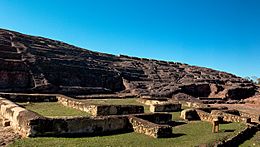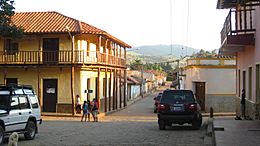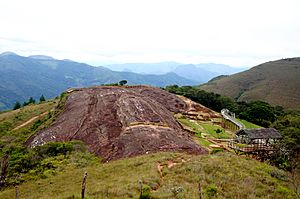Samaipata, Bolivia facts for kids
Quick facts for kids
Samaipata
Samaypata
|
|||
|---|---|---|---|
|
Town
|
|||
|
Samaipata
|
|||
|
|||
| Country | Bolivia | ||
| Department | Santa Cruz Department | ||
| Province | Florida Province | ||
| Municipality | Samaipata Municipality | ||
| Population
(2012)
|
|||
| • Total | 4,398 | ||
| Time zone | UTC-4 (BOT) | ||
Samaipata (also called Samaypata) is a charming small town in Bolivia. Its name comes from the Quechua language, meaning "place of rest" or "elevated place." This town is located in the Florida Province of the Santa Cruz Department. It sits in the foothills of the Andes mountains, about 120 kilometers southwest of the city of Santa Cruz de la Sierra.
Samaipata has a pleasant subtropical climate and is quite high up, between 1600 and 1800 meters above sea level. Many people from Santa Cruz visit Samaipata because of its cooler weather. The town has many old colonial buildings and narrow streets made of cobblestones. It's also a great starting point for exploring nearby attractions like the ancient site of El Fuerte de Samaipata, the Amboro National Park, and the beautiful Cuevas waterfalls.
Contents
Where is Samaipata Located?
Samaipata is a special place recognized by UNESCO as a World Heritage Site. It is found in the Florida province within the Santa Cruz department of Bolivia. The town is in a hilly area that divides the dry western parts of the country from the eastern jungles. The closest big city is Santa Cruz de la Sierra, which is the largest city in Bolivia.
What is Samaipata's History?
The valley where Samaipata is located was first home to the Chane people. They were farmers, hunters, and gatherers. The Chane people were known for their busy villages, beautiful pottery, and for building a temple at El Fuerte de Samaipata. They mostly grew corn and peanuts and were generally peaceful. You can find many Chane burial sites throughout the valleys of Santa Cruz.
Later, the Incas expanded their empire from Peru and took over this region. The Incas made an agreement with the Chanes and built a city next to the Chane temple at El Fuerte de Samaipata.
In the 1500s, Guarani warrior tribes, also called Chiriguanos, invaded the valley from the south. They defeated both the Incas and the Chanes. The Guarani continued to raid the area for many years, even into the 1800s.
In 1618, a man named Pedro de Escalante y Mendoza founded Samaipata. It was meant to be a link between Santa Cruz and Vallegrande. The town later moved a few kilometers west to where it is today.
Who Lives in Samaipata?
Samaipata is a very diverse town with people from many backgrounds. The older families in Samaipata are descendants of Spanish colonists from Vallegrande and Santa Cruz. Many of these Spanish settlers had Sephardic roots. They mixed with the local Guarani natives who lived in the valley before the Spanish arrived.
Starting in the 1880s, some Arab families moved to Samaipata. Later, a few Croatians and Italians also settled there. All these groups blended into the local population.
After a main road was paved in the 1960s, many people from other parts of Bolivia, especially from nearby Santa Cruz, but also from Cochabamba and Sucre, moved to Samaipata. Since the 1970s, people from Germany, the Netherlands, France, Argentina, and Japan have also made Samaipata their home, making it a truly international town.
What is Samaipata's Economy Like?
The main ways people make a living in Samaipata are through tourism, farming, and making crafts. Local farmers grow organic vegetables like tomatoes, artichokes, and green beans. The region is also famous for its delicious fruits such as peaches, grapes, plums, and strawberries.
Samaipata also produces wines, a local spirit called singani, honey, and jams. You can find handmade crafts, herbal teas, and lavender products here too. The town's market is a lively place where you can find many of these local goods.
What is the Climate in Samaipata?
Samaipata has a subtropical highland climate. This means it has mild temperatures all year round, with an average of about 19.9 °C (67.8 °F). The winter months are a bit drier.
During winter, cold winds called Surazos can blow in from the Argentine Pampas. These cold winds, combined with the town's high altitude, can sometimes make temperatures drop below freezing. In the summer, the days are warm, but the nights are cool. Frost happens about nine days a year, mostly in the winter.
| Climate data for Samaipata, Bolivia. 18 11 S, 63 53 W. Elevation: 1,647 metres (5,404 ft) | |||||||||||||
|---|---|---|---|---|---|---|---|---|---|---|---|---|---|
| Month | Jan | Feb | Mar | Apr | May | Jun | Jul | Aug | Sep | Oct | Nov | Dec | Year |
| Daily mean °C (°F) | 21.7 (71.1) |
21.4 (70.5) |
21.2 (70.2) |
19.8 (67.6) |
18.3 (64.9) |
17.4 (63.3) |
16.7 (62.1) |
18.1 (64.6) |
19.8 (67.6) |
21.0 (69.8) |
21.5 (70.7) |
21.7 (71.1) |
19.9 (67.8) |
| Average precipitation mm (inches) | 121.3 (4.78) |
125.7 (4.95) |
95.3 (3.75) |
48.2 (1.90) |
27.3 (1.07) |
28.6 (1.13) |
13.5 (0.53) |
35.4 (1.39) |
32.5 (1.28) |
44.5 (1.75) |
78.8 (3.10) |
117.5 (4.63) |
768.6 (30.26) |
| Source: Weatherbase: Samaipata, Bolivia. | |||||||||||||
Wine Making in Samaipata
Samaipata has a long history of making wine, going back to when the first Spanish settlers arrived. Although wine production slowed down for a while, it has recently become one of the most important wine regions in Bolivia. It is now the second largest wine-growing area and attracts more and more tourists, especially from Santa Cruz.
There are three main wineries in the region: Uvairenda (which makes the 1750 Wines), Bodegas Landsua, and El Último Vargas. Samaipata is located about 1,750 meters (5,740 feet) above sea level. This high altitude and good weather make it a great place for growing grapes and producing high-quality wines that are popular in Bolivia.
The main types of grapes grown here are Tannat, Cabernet Sauvignon, Syrah, Barbera, Malbec, and Torrontés. These grapes are becoming very important for the region's wines. Other grapes like Cabernet Franc, Sauvignon Blanc, and Riesling are also grown, but in smaller amounts.
Many of Samaipata's vineyards are close enough to the town center that you can walk to them. Most vineyards offer guided tours where you can learn about wine making and enjoy a wine tasting at the end.
Gallery
El Fuerte de Samaipata: An Ancient Mystery
Close to Samaipata is the ancient ruin of El Fuerte de Samaipata. Even though it's called a "fort," it was actually a temple. This is the largest pre-Inca site in Bolivia.
In 1998, UNESCO declared it a World Heritage Site. This archaeological area shows ruins from the Chane people (who lived there before the Incas), the Incas, and even Spanish colonial times. The temple was carved into a huge rock, likely by the Arawak people, probably from the Chane culture. The Incas also built a city next to the temple. They formed alliances with the Chanes to protect their lands from attacks by Guarani warrior tribes.
It is believed that the Guarani warriors eventually defeated both the Chanes and the Incas. By the time the Spanish arrived, the Guarani tribes controlled the area, and El Fuerte was already destroyed. The Spanish also built a town near the temple, but it was later abandoned.
There are some very interesting features at the site, including a sloping ramp. Some people, like the author Erich von Däniken, have even suggested it was a launchpad for spaceships! To protect the ancient carvings, some parts of the site are now closed off to visitors.
Las Cuevas: Waterfalls and Pools
Another interesting place nearby is Las Cuevas. It's a lovely spot for a walk along streams and past waterfalls. There are several natural pools and small beaches where you can relax. There is a small fee to enter, but camping is not allowed.
See also
 In Spanish: Samaipata para niños
In Spanish: Samaipata para niños




















